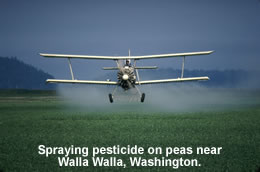
 |
| Home > Policy Issues > Regulating Pesticides > Introduction | ||
IntroductionThere is growing public concern regarding pesticide exposure, and for good reason. Studies have shown that all persons, but especially children, pregnant women, farmers, farmworkers, and the elderly, may experience negative health effects from exposure to pesticides. Among the negative health effects resulting from pesticide exposure are acute poisoning, cancer, neurological damage, birth defects, and reproductive and developmental harm.(1) Evidence has accumulated that many commonly-used pesticides can suppress the normal response of the human immune system, making the body more vulnerable to invading viruses, bacteria, parasites, and tumors, and increasing the incidence of disease and some cancers.(2) Some evidence indicates that pesticides may reduce male sperm counts.(3) Unfortunately, pesticides are widely used in our environment to control pests and we, as citizens, are seldom told about it. Fortunately, many solutions exist to reduce pesticide use and exposure. We present two methods in our sample legislation: Integrated Pest Management (IPM) and Pesticide Posting and Notification. Integrated Pest ManagementIntegrated pest management (IPM) is an approach that combines “common sense” non-chemical control techniques with the limited use of pesticides. The term IPM means: |
||
|
||
IPM is a more effective means of pest control than conventional methods and has significantly less impact on environmental health and safety. IPM is already a part of many extension office programs and is required at all federal agencies, but it is not a requirement for state pest management programs. Pesticide Posting and NotificationOur Pesticide Posting and Notification bill utilizes the “right-to-know” philosophy, which would require individuals applying pesticides to post a warning sign near the area of the application and, in some cases, notify residents or tenants of the pesticide application. This sample bill would allow the public to control their pesticide exposure. Similar legislation has met success in other states where it has been implemented. The information contained in this policy issues package is designed to assist state legislators, concerned citizens, and environmental advocates in their efforts to address pesticide issues within their states. This web site offers background information, talking points, a fact pack, frequently asked questions, and sample bills. We may have other useful materials on this subject, which are not posted on our web site. Please feel free to contact us at [email protected] or call our office in Madison, Wisconsin, at (608) 252-9800. If you’ve used this site and found it helpful or, if you have suggestions about how it could be made more helpful, please let us know. Feel free to use the sample bill text included here in your state. If you do, please notify us. SERC would like to thank the knowledgeable staff at the Northwest Coalition for Alternatives to Pesticides (NCAP), and Kagen Owens of Beyond Pesticides for their assistance in the creation of this package. |
||
| Sources: (1) Mott, Lawrie, et al. “Our Children At Risk: The 5 Worst Environmental Threats To Their Health, Chapter 5: Pesticides.” National Resources Defense Council. November 1997. 16 September 2004 <http://www.nrdc.org/health/kids/ocar/chap5.asp>. (2) Repetto, Robert and Sanjay S. Baliga. “Pesticides and the Immune System: The Public Health Risks.” Washington, D.C.: World Resources Institute, 1996. 16 September 2004 <http://pubs.wri.org/pubs_description.cfm?PubID=2704>. (3) Swan, Shanna H., et al. “Semen Quality in Relation to Biomarkers of Pesticide Exposure.” Environmental Health Perspectives 111.12 (September 2003). ehp online. 14 September 2004 <http://ehp.niehs.nih.gov/docs/2003/6417/abstract.html>. (4) State of California. California State Assembly. “Healthy Schools Act of 2000.” 1999-2000 Regular Session, Assembly Bill No. 2260. Introduced 24 February 2000. Chaptered 27 September 2000. Official California Legislative Information. 16 September 2004 <http://www.leginfo.ca.gov/pub/99-00/bill/asm/ab_2251-2300/ab_2260_bill_20000927_chaptered.pdf>. |
||
| This package was last updated on September 19, 2004. |
